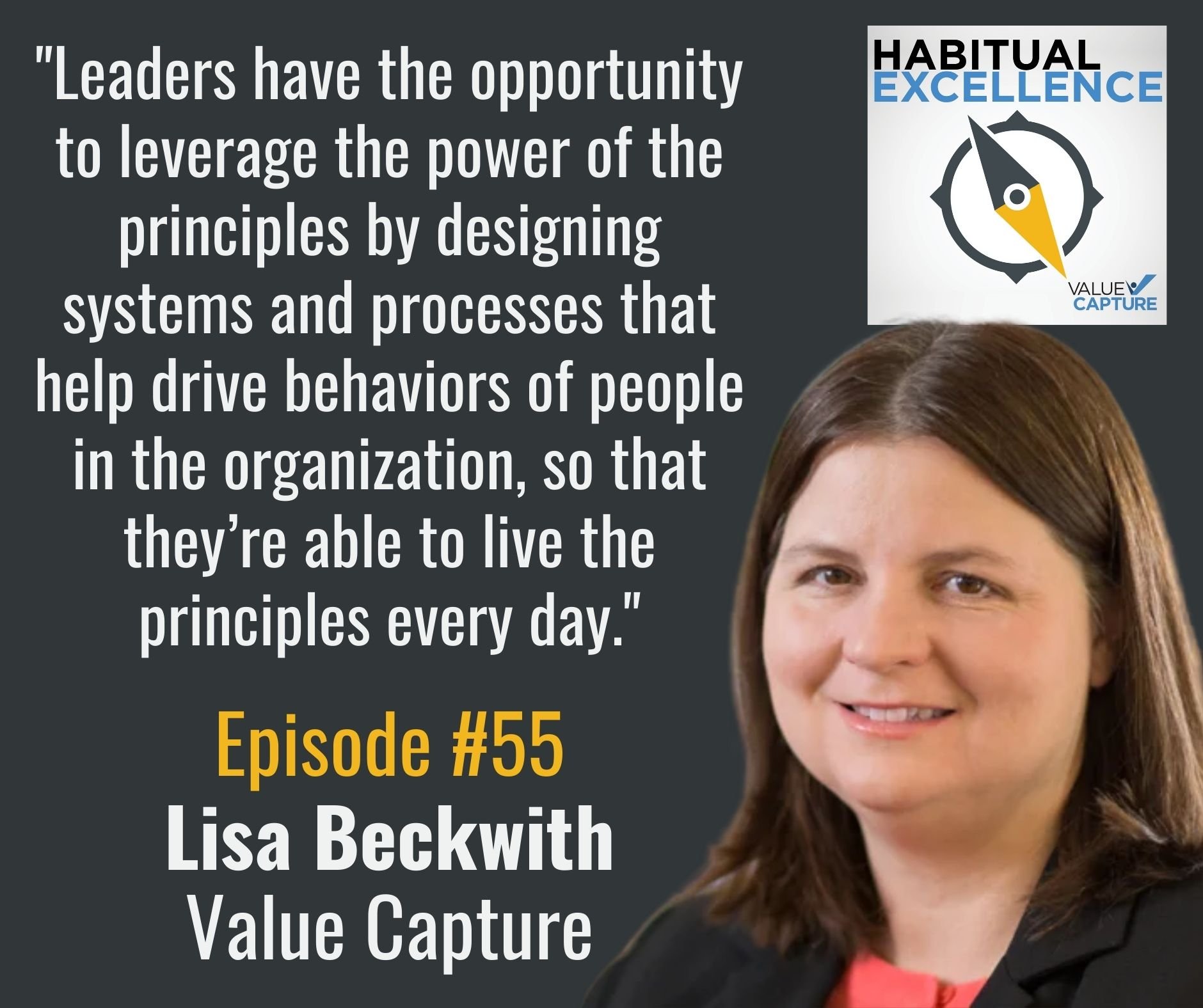Listen:
Scroll down for a transcript, video, how to subscribe, and more
Notes:
Welcome to Episode #55 of Habitual Excellence, presented by Value Capture.
 In today's episode, our guest is Lisa Beckwith, a Senior Advisor with Value Capture. In this episode, Lisa explains the two Shingo Guiding Principles, "Respect Every Individual" and "Focus on Process," and the relationship between them.
In today's episode, our guest is Lisa Beckwith, a Senior Advisor with Value Capture. In this episode, Lisa explains the two Shingo Guiding Principles, "Respect Every Individual" and "Focus on Process," and the relationship between them.
You can watch a video or listen to the podcast. A full transcript also follows.
- The Power of Principles
- Respect Every Individual - Why is it Important for Excellence?
- An Example of a Leader Modeling Respectful Behaviors
- Ignoring the Principles
- What Can Leaders Do?
- How “Focus on Process” Drives Respect into the Organization
- Focus on Process Brings Clearer Vision and Understanding
- Grasp the Current Condition
- Engaging and Improving Via the Management System
Watch the Episode:
Quotes:



Podcast Main Page:
Click to visit the main Habitual Excellence podcast page.
Subscribe:
To make sure you don't miss an episode, be sure to subscribe today! Please rate and review the podcast.
Transcript:
Introduction
Hello. I am Lisa Beckwith, a Senior Advisor at Value Capture. I work with client hospitals and health systems to help them in reaching their safety and quality goals, and in the process of doing that work, I help them drive the principles of organizational excellence into their organizations. These principles are also known as the Shingo Principles.
As part of the Value Capture series on the Shingo Principles, I am going to focus today on two really important principles that I feel go hand-in-hand. They are “Respect Every Individual” and “Focus on Process.”
The Power of Principles
Let’s first think about the power of principles. They are universal. They exist in all industries, including healthcare. There are foundational truths that underlie the principles that actually help us to predict consequences. As leaders, we can learn about the principles and recognize that they can help us to predict the consequences of our own behaviors and actions.
Leaders have the opportunity to leverage the power of the principles by designing systems and processes that help drive behaviors of people in the organization, so that they’re able to live the principles every day. They can also help us to understand the negative consequences that may occur if we ignore the principles. Principles actually tell us what to do. What are the actions that people can take?
When I consider the principle of Respect Every Individual and think about how leaders can do their work in a way to show respect for everyone, I think that the principle of Focus on Process is closely linked because it describes what leaders need to do to demonstrate that respect. They can do their work respectfully by focusing on process.
There is also a close connection between values and principles. Values govern our actions. Values are standards of behaviors that we believe to be true and we hold dear to our hearts. But principles actually govern the consequences of our behaviors or actions.
So when our values are aligned with the principles, we can achieve the positive consequences of our actions for which we are striving. We may choose to respect someone because that is our value and the principle helps us to predict the consequence of that action.
Respect Every Individual - Why is it Important for Excellence?
Let’s start with the principle of Respect Every Individual. Why is it a principle of organizational excellence and why is it so important?
People deserve respect simply because they are human beings. Every person on the planet deserves respect. We can see that there are powerful consequences if everyone lives this principle and we also see powerful consequences of when we don’t live the principle. We hear about them in the news of our country and world every day.
The action that we need to take is: respect. The verb is respect. What does respect look like? What are actions that show respect? Who should we respect? We should respect not only groups of people, not most of the people most of the time, but every person. Every individual that we interact with deserves our respect.
When we find ourselves acting in a way that is respectful of other people, we can predict the consequences that may result. We may gain trust with others, we might have a more engaged workforce, and we can better serve our customers.
When we do not respect others, we can also predict the undesirable consequences that can also occur. Unhappy staff can lead to a decrease in productivity, there may be staff turnover, and staffing shortages, and unhappy customers that receive their goods and services from us can go elsewhere.
When we think about how we show respect, we think about what our actions imply. Take a minute to think about what actions come to mind for you.
An Example of a Leader Modeling Respectful Behaviors
I’d like to share an example of a leader who embodied the principle of Respect Every Individual and modeled the principle in every aspect of his life. Value Capture’s [mentor], Paul O’Neill, aspired to enable a culture in which respect for every individual was alive and well at Value Capture and earlier in his career as the CEO of Alcoa.
He firmly believed that in organizations that truly are excellent, leaders create the conditions by which the employees can answer “yes” to three really important questions.
The first is “Am I treated with respect by everyone I encounter without regard to race, gender, educational attainment, rank, or any other distinguishing feature?
That may be really hard for people in general to say yes to, but he truly believed that in great organizations, people are able to say yes.
The second question has to do with how people are set up to succeed in their work. The question is, “Am I given the tools, training, resources, encouragement, to make a contribution to the organization that adds meaning to my life?”
He believed that people should do work that not only creates value for their customers and the organization but is also fulfilling for the worker.
The third question is, “Am I recognized for that contribution by someone whose
opinion matters to me?”
These questions, and aspiring to create the conditions for people to be able to answer “yes” to the questions are ways to show respect for people. People come to work every day to do a great job. They want to meet their customer needs. In healthcare, they want to care for their patients. They need to be able to do their work in a culture that is open and accepting of them and one that fosters them using their expertise in doing their work, as well as learning, improving, and sharing.
The role of leaders is to create these conditions and support the workers to be successful in their work.
Paul O’Neill led Alcoa using these principles and actions to bring them to life, to help Alcoans to work in the safest organization in the world. When he was at the helm of Alcoa, it was 27 times safer to work in an Alcoa plant than it was to work in an American hospital. Alcoa has been able to maintain a great safety record over the years since he left as its CEO.
Ignoring the Principles
In contrast, we can think about consequences derived from an example of ignoring the principle of Respect Every Individual.
In many organizations, especially in healthcare, reporting of incidents of harm to workers and also patients is a requirement. This is a good thing, because once we understand that harm events or risks of harm exist, we can begin to surface the problems, understand them, and solve them to root to eliminate them from happening again.
People deserve this. They deserve the opportunity to be able to identify the problems that occur in the course of their own work, so that they can get help in solving them and make them go away. People have really important work to do and should not be burdened with system problems.
In a culture of disrespect, however, there are often punitive actions that occur as a result of reporting incidents. People say they make a mistake, they get reprimanded. They may have a corrective action plan or may even get a few warnings before they get fired. These types of responses to people identifying and reporting problems in their work is a demonstration of terrible disrespect for workers. It is disrespectful not only for the people, but also for the organization.
One could predict that the consequences of these behaviors would be to drive the underreporting of incidents. This underreporting deprives the organization of opportunities of learning from things gone wrong and the ability to improve the work. This allows the harm to occur to other people over and over and over again.
I’ll share a tangible example of this. When I was working with an organization, I learned about a situation that occurred when a nurse was administering a liquid medication to a patient. She had to measure the liquid in an oral syringe from a bulk bottle. This happened to be a controlled substance, and at the conclusion of the activity, there was a discrepancy in the count of the liquid in the automated medication station.
In my mind, I was thinking that the nurse manager would work with the nurse to understand what happened to try to solve it to its root cause. That’s not what happened. The first thing that happened was that the nurse was subjected to a drug test to see if she had actually consumed the medication that was missing.
I don’t know if it was a policy or not but it just seemed to me it was just so disrespectful of that person. Here we are, an organization that puts our patients’ lives in the hands of our nurses to care for them every day, but we don’t trust the nurses enough to engage in a conversation about what happened?
Of course, when the drug test came back negative, they dug into how the process broke down, and they were able to understand what caused the problem to allow for an inaccurate count, and found the actual cause of the discrepancy. Unbelievable.
Another example from a different organization occurred when a medication that was repackaged from a bulk container into a unit-of-use package so that it could be dispensed individually, was mislabeled. Hydralazine, which is a blood pressure medication, was labeled as hydroxyzine, which is an antihistamine. One would think, wow, those are very similar names. This technician is not the only person who has confused the names. In fact, they are referred to in the industry as “look alike - sound alike” medications. It’s not hard to understand how one could be mistaken for the other. What can we do to prevent this from happening again?
Well, what actually happened was that the technician who made the error was sent for an eye exam. As you might imagine, his glasses were the right prescription for him. He was taken out of the role of the pharmacy compounder. The role was not only responsible for repackaging medications but also for compounding creams, liquids, and capsules, whatever the pharmacy needed. It’s not the type of role that is for everyone. He was a very creative person. He loved that role. He did it for 11 years. He just loved his job. It was an art and he did it so well. But one mistake and he was taken out. He was assigned to be a delivery technician which he really did not like to do.
So here we are. We are not focusing on the process. We’re not trying to solve the problem. Hydralazine and hydroxyzine still look and sound alike. They still are close to each other on the shelf. They never really addressed the root cause. Just blamed the person. Embarrassed the person. Of course, he can read. There is complete disrespect for this person. Will this problem recur? You can bet on it.
These types of behaviors drive underreporting. People are afraid to say that something went wrong or a mistake was made. Naturally, they do not want the mistakes to happen either. When there are vulnerabilities in a process, mistakes can occur.
What Can Leaders Do?
So, what can leaders do if they want to drive respect for everyone in the organization?
Leaders can seek out situations in their organizations that do not demonstrate respect for everyone. There may be hundreds of examples in every organization. The challenge to leaders is to find them and to address them.
One of the most important things that we can do as leaders is to open our eyes to it and make it a focus of what we want to do. Look at the organization through the lens of respectful behavior.
How “Focus on Process” Drives Respect into the Organization
This leads us to the next principle, “Focus on Process.” This is something that leaders can do to drive the principle of Respect Every Individual into the organization.
This is a short phrase, Focus on Process, but it is so powerful if we can apply it to our work. “Focus.” Focus means that our attention is drawn to a very particular place or subject that we want to understand or study. When we focus on something, it draws our attention away from other things. The principle tells us that our focus should be on the process.
How ever you think about process - the work steps, standard work, protocols, procedures, value streams - this is where the focus should lie when you are trying to understand, improve, and when you are trying to define best practices. The focus of your brain should be on the process and not on the people.
People have to work within a process. Leaders, especially middle managers, leaders of departments, and directors, these are the people who are really responsible for the systems and processes that the people work within. The frontline staff, the nurses who are subject to caring for their patients have to work within the process. It behooves every leader to focus on their process to understand how the process is designed and the vulnerabilities within the process.
Another benefit for leaders focusing on the process is that it provides them a way to find a deep appreciation for the work that people do, the care that they provide to their patients, it helps them see the creativity and ingenuity and understand improvement ideas that people have.
Focus on Process Brings Clearer Vision and Understanding
I’ll share some examples of this appreciation. At Value Capture, one of our favorite exercises that we do with leaders is to help them to “see,” we help them to see process. We take them out to the frontline. We typically work in hospitals. We often taken them to the bedside with a nurse or another caregiver for 30 minutes. Silently. They have their mouths closed and their eyes and ears open. They are observing work. They see the person. They see the caregiver. They see how caring the person is, how hard the person is working, how many tasks they have to accomplish in a short time. They see how frequently they need to move. Back and forth across the room. Across the unit, between patient and supply rooms, between medication rooms and the nursing station. They see the documentation, the phone calls, the conversations that are necessary to care for their patients. All of the work that is necessary is done usually flawlessly by the nurses.
Simultaneously, as they focus on the person working within the process, they see the problems that staff encounter.
They see barriers to doing the work and they see risks of harm. They may not have the right information, or the worker may have to wait for a supply or medication or someone to call them back to clarify an order.
Upon reflection of the experience, leaders describe the workers as caring, even loving, calm, organized, multi-taskers. They recognize that people are methodical. They appreciate all of these things that people do.
They also reflect that the process is set up in a way that makes it hard for the people to do their work. They learn to separate the people from the problems.
This exercise is easy for leaders to do. Go to the work and observe. Create the psychological safety needed to be in the workspace and just learn. Take a step back and silently observe. It can be a very eye-opening experience. I worked with a CEO once who said that when he needs a shot in the arm, he goes to a nursing unit to observe a nurse for a bit.
Grasp the Current Condition
There are a few articles that were written by Steve Spear that can be great resources in helping us to better understand the design of processes. These articles are “Decoding the DNA of the Toyota Production System” and “Grasping the Current Condition: Pathways and Connections.”
Once you’ve learned to understand process and how work is designed for an individual trying to meet a need, you may ask a few questions to help you better understand the remainder of the process. How do the individuals connect with each other? What does that look like? How are they able to get the information they need to do their work? Who are all of the people and roles necessary to deliver a medication or a lunch tray to a patient? What are the human resources and the material resources necessary to be able to do that work?
Leaders can really see what it takes to focus on process.
When you hear about problems in the process, you can engage the very same people to solve the problem; asking why the problems exist and what can we do to eliminate those barriers.
Engaging and Improving Via the Management System
Engagement in management system and improvement activities is another way that leaders can focus on process. In a client hospital, every morning at 7:00 a.m., you can find the Emergency Department nurse manager and assistant nurse manager at the team’s daily huddle. They are present, they are engaging and they are listening to their team.
These daily huddles provide an opportunity for them to plan for the day, engage their people in the department, and share learning from problem solving and improvements made. They have built this into their daily leader standard work as well as being responsive to the team when problems occur in the course of work. Like leaders in many organizations, they are the glue that holds it all together.
Without their dedication and efforts and focus on the process, there would not be a management system. Leaders design management systems to foster those behaviors and actions that leaders need to do to be able to support their teams in meeting their customer needs.
When should a leader focus on process? The correct answer would be all of the time, but here are a few specific examples.
First, every process is perfectly designed to get the outcomes that it gets. What can you learn about your outcomes? What are your KPIs, or key performance indicators, telling you about the process? Why have you selected the KBIs, the key behavioral indicators that you have? How are the behaviors helping you to achieve the results that you want to achieve? If you are not happy with the outcomes or results, then it is really important to focus on the process to understand why it is producing these results.
Leaders can be proactive and design their own leader standard work to stay on top of the processes. What do I have to do to plan and prepare for my day? Are we appropriately staffed? Do we have the supplies that we need? Do people have the skillset necessary to care for the patients today? How will I support my team today? How can I use direct observation of work to help me better understand the current condition of our processes? How will I develop people today?
Leaders can also respond reactively when a problem occurs. Be there. Be there with the team. Helping them to focus on how we can solve the problem and get our process working again and how can we prevent this from happening again?
Leaders can focus on the process when they are leading, teaching and coaching others. Engaging in humble inquiry to develop another person’s thinking and listening to people are strengths of great leaders.
It is really important for leaders to focus on the process when they are trying to evaluate customer need. How are we doing delivering that need to our customers? Are we providing the right things to them or are we producing things that they really aren’t asking for? In healthcare, what would the patient be willing to pay for? Talking to customers helps us to understand what they need.
Leaders focus on process when designing systems that help people to be successful in their work. Managers and leaders are ultimately responsible for those systems and processes that people use every day to meet their customer needs.
Conclusion
As human beings, we all have the right and the desire to feel respect from everyone we encounter and we strive to live the principle “Respect Every Individual.” As leaders of people in every industry and walk of life, we have the unique opportunity to focus on process to improve and design systems that drive the behaviors that help people to create value for other people in a culture that demonstrates respect for every individual.

Written by Mark Graban
Mark Graban has served healthcare clients since 2005. Mark is internationally recognized as a leading author and speaker on Lean healthcare. His latest book is "The Mistakes That Make Us: Cultivating a Culture of Learning and Innovation."


Submit a comment